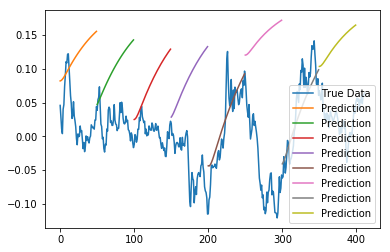[Model] Model Compiled
Time taken: 0:00:00.809316
[Model] Training Started
[Model] 2 epochs, 32 batch size, 124 batches per epoch
Epoch 1/2
124/124 [==============================] - 45s 363ms/step - loss: 0.0022
Epoch 2/2
1/124 [..............................] - ETA: 36s - loss: 6.4717e-04
---------------------------------------------------------------------------
ValueError Traceback (most recent call last)
<ipython-input-27-e3c645699881> in <module>()
76
77 if __name__=='__main__':
---> 78 main()
<ipython-input-27-e3c645699881> in main()
58 batch_size = configs['training']['batch_size'],
59 steps_per_epoch = steps_per_epoch,
---> 60 save_dir = configs['model']['save_dir']
61 )
62
/notebooks/storage/core/model.py in train_generator(self, data_gen, epochs, batch_size, steps_per_epoch, save_dir)
81 epochs=epochs,
82 callbacks=callbacks,
---> 83 workers=1
84 )
85
/usr/local/lib/python3.5/dist-packages/keras/legacy/interfaces.py in wrapper(*args, **kwargs)
89 warnings.warn('Update your `' + object_name +
90 '` call to the Keras 2 API: ' + signature, stacklevel=2)
---> 91 return func(*args, **kwargs)
92 wrapper._original_function = func
93 return wrapper
/usr/local/lib/python3.5/dist-packages/keras/engine/training.py in fit_generator(self, generator, steps_per_epoch, epochs, verbose, callbacks, validation_data, validation_steps, class_weight, max_queue_size, workers, use_multiprocessing, shuffle, initial_epoch)
1413 use_multiprocessing=use_multiprocessing,
1414 shuffle=shuffle,
-> 1415 initial_epoch=initial_epoch)
1416
1417 @interfaces.legacy_generator_methods_support
/usr/local/lib/python3.5/dist-packages/keras/engine/training_generator.py in fit_generator(model, generator, steps_per_epoch, epochs, verbose, callbacks, validation_data, validation_steps, class_weight, max_queue_size, workers, use_multiprocessing, shuffle, initial_epoch)
211 outs = model.train_on_batch(x, y,
212 sample_weight=sample_weight,
--> 213 class_weight=class_weight)
214
215 outs = to_list(outs)
/usr/local/lib/python3.5/dist-packages/keras/engine/training.py in train_on_batch(self, x, y, sample_weight, class_weight)
1207 x, y,
1208 sample_weight=sample_weight,
-> 1209 class_weight=class_weight)
1210 if self._uses_dynamic_learning_phase():
1211 ins = x + y + sample_weights + [1.]
/usr/local/lib/python3.5/dist-packages/keras/engine/training.py in _standardize_user_data(self, x, y, sample_weight, class_weight, check_array_lengths, batch_size)
747 feed_input_shapes,
748 check_batch_axis=False, # Don't enforce the batch size.
--> 749 exception_prefix='input')
750
751 if y is not None:
/usr/local/lib/python3.5/dist-packages/keras/engine/training_utils.py in standardize_input_data(data, names, shapes, check_batch_axis, exception_prefix)
125 ': expected ' + names[i] + ' to have ' +
126 str(len(shape)) + ' dimensions, but got array '
--> 127 'with shape ' + str(data_shape))
128 if not check_batch_axis:
129 data_shape = data_shape[1:]
ValueError: Error when checking input: expected lstm_1_input to have 3 dimensions, but got array with shape (8, 1)
Did some debugging using the example config for stock market prediction. For each step in epoch 1, generate_train_batch yields two arrays x_batch and y_batch of shape (32, 49, 1) and (32, 1) respectively.






